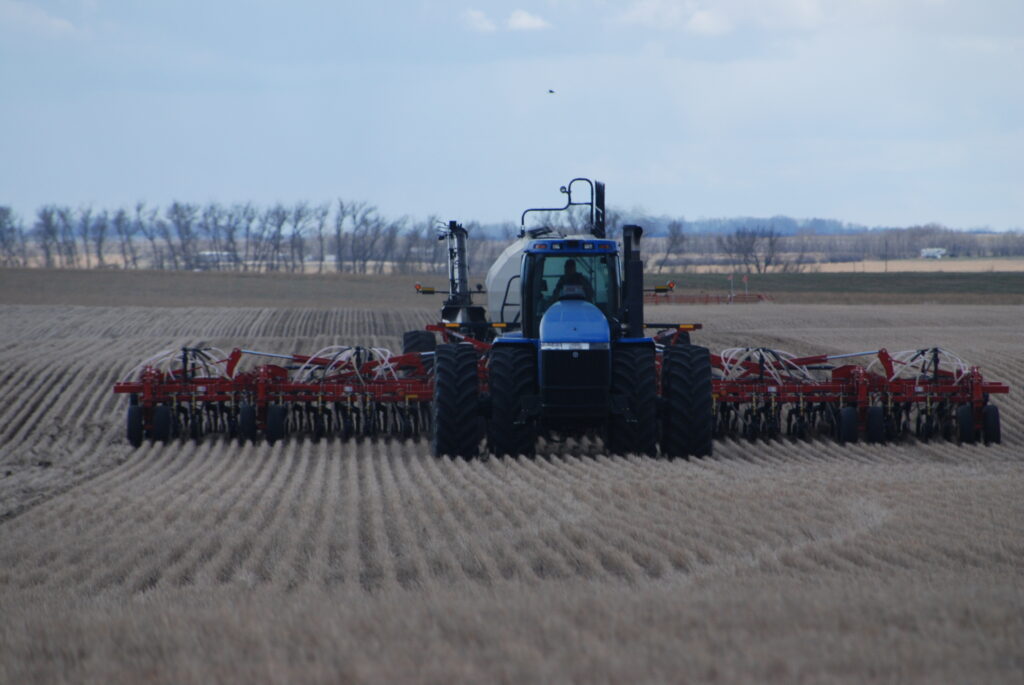
Features
Environment
Top Crop Summit
Top Crop Summit series: Preparing for and managing after a drought
April 12, 2024 By Bruce Barker
 Look at the cost-benefit analysis when considering cutting nitrogen fertilizer in dry years.
Photo by Bruce Barker
Look at the cost-benefit analysis when considering cutting nitrogen fertilizer in dry years.
Photo by Bruce Barker Lyle Cowell is the senior agronomist with Nutrien Canada. At the Top Crop Summit on Feb. 27-28 in Saskatoon, he shared how to adapt management practices to best mitigate the downside of dry conditions and addressed what agronomic steps can be taken to protect farm profitability during a drought.
Drought has always been a part of the Prairie landscape, but sometimes it is what we make of it. We tried to mitigate drought with summer fallow. Summer fallow was a bad idea that we clung to for decades, which only led to reduced soil quality and lower water-holding capacity.
The four things that increase yield are sunshine, adequate water, adequate nutrients and superior genetics. Lessons learned in the 1980s showed that you should keep the water that you are given by capturing snow, minimizing tillage and controlling weeds. We can ‘invest’ in water through irrigation but should first focus on efficient use of the free water from precipitation.
Fertilizer accounts for about 20 per cent of total variable and fixed costs for a typical wheat crop, with nitrogen (N) making up about 15 per cent of total costs. Under a scenario where N rates are reduced from 90 pounds N per acre to 70 lbs., the savings would be about $15 per acre. This saves about four per cent of total farm costs and about nine per cent of variable costs.
But at what cost? Based on a soil test of 20 lbs. N per acre, a reduction from 90 to 70 lbs. N per acre would reduce wheat yield potential from 51 to 43 bushels per acre. A total farm cost saving of four per cent may result in a potential gross farm income loss of 16 per cent and probable net loss per acre.
Instead of reducing nitrogen fertilizer use, apply N fertilizer where it is required the most and to fields with the most N response potential. Use high rates for canola, CWRS wheat and feed barley; moderate rates for flax, malt barley and oats; no N required for pulses or forage legumes.
Focus on fertilizer use efficiency. Soil test, consider crop requirements per bushel, vary rates to match yield potential, and apply the right products at the right time and in the right place.
Research has long proven that banding N is more efficient than broadcasting because of less gaseous loss, less immobilization, less water loss and less weed use of N and water. Banding also causes a proliferation of roots in the zone around the banded fertilizer, which can increase the uptake of N, other nutrients and water.
Apply the correct nitrogen rate to balance soil test results and use realistic yield targets and crop removal rates. An updated nutrient uptake and removal calculator can be found at prairienutrientcalculator.info/. Nutrient removal per bushel does not vary much by yield or drought. For example, barley N removal per bushel of yield removes approximately 0.80 lbs. N/bu. at 30 bushels or 130 bushels yield.
Sulphur fertilizer can also be managed using variable application, especially in fields affected by salinity, as most salts in Western Canada soils are sulphates. Saline areas will be both high in available sulphur and have low yield potential. In dry years, salts will be left higher in the soil profile to cause accumulation in the seedbed. In some fields, fertilizer efficiency can be improved by seeding salt-tolerant forages.
Regarding sulphur fertilizer during dry years, elemental sulphur fertilizers oxidize slowly into plant-available sulphate forms. For this reason, it is often wise to supplement elemental sulphur with ammonium sulphate in rotational applications.
For less mobile nutrients like phosphorus (P) and potassium (K), drought may impact the movement of nutrients by diffusion and uptake potential, so deficiency tends to be worse in cold and dry springs. For this reason, the best efficiency of P and K will be if placed near the crop seed row.
Dry soil will increase the risk of excess fertilizer applied near the seed. Caution should be used with seed row fertilizer to avoid damaging germination and emergence. Recommendations for the maximum amount of seed row fertilizer are based on adequate moisture conditions. Take steps to reduce this crop risk.
Maximize immobile nutrients like P and K in the seed row while reducing N and S. Do not dry out the seedbed with tillage. Increase seedbed utilization so that the seed and fertilizer are spread further apart. Cereal crops are more tolerant of seedbed fertilizer than sensitive crops like canola, which allows nutrients to be managed across a rotation. Salinity, cold soil, damaged seed and disease will make the crop more susceptible to damage from seed row fertilizer.
Placement of seed row fertilizer can also help improve safety. For example, a side-band placement that separates seed and starter fertilizer can reduce risk. If you are concerned about excess urea near the seed row, using ESN alone or in a blend with the urea will improve safety in all soil conditions.
While we do not understand the impact of soil water on nutrient cycles very well, we do know that nutrients and water build yield. This underlines the importance of applying fertilizer to equal soil supply and crop yield potential per acre. In Western Canada, water and nutrients grow grain. Don’t waste the water you have, and you will improve both water use efficiency and fertilizer use efficiency.